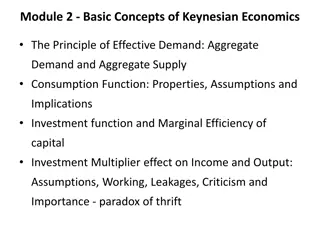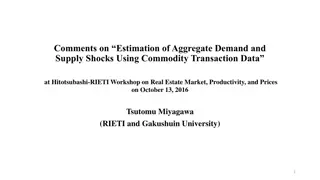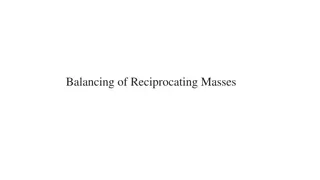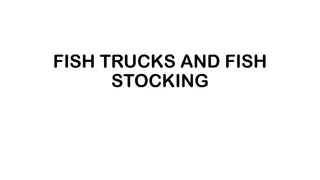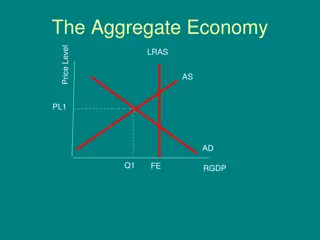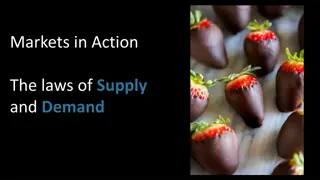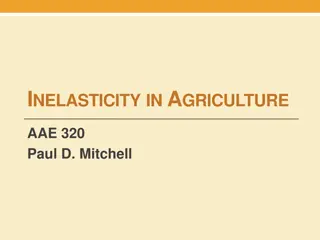Setting Stocking Rate: Four-Step Procedure for Balancing Supply with Demand
To set stocking rates effectively, follow a four-step procedure that involves balancing supply with demand. This method helps estimate carrying capacity, adjust for changes in animal types, and more. The process includes calculating usable forage, adjusting for terrain accessibility, determining forage demand, and calculating the stocking rate. Through these steps, ranchers like Mollie can better manage their land resources for sustainable usage.
Download Presentation

Please find below an Image/Link to download the presentation.
The content on the website is provided AS IS for your information and personal use only. It may not be sold, licensed, or shared on other websites without obtaining consent from the author. Download presentation by click this link. If you encounter any issues during the download, it is possible that the publisher has removed the file from their server.
E N D
Presentation Transcript
How do you set stocking rate? Four-step procedure: Balance supply with demand Karen Launchbaugh Rangeland Ecology & Management University of Idaho
4-Step Forage Demand Method 1. Calculate usable forage 2. Adjust for accessibility (terrain or water) 3. Calculate forage demand of animals 4. Calculate stocking rate The forage demand method is used: When you have no stocking information from previous years. To estimate carrying capacity in biological surveys or land appraisals. When considering changes in kind or class of animals.
Step 1 - Calculate Usable Forage: Mollie Texan has a ranch in the southern mixed prairie that is 1,000 acres big. 75% of it is covered by a sandy loam range site that produces 1,500 lb/acre/year. The other 25% is a shallow uplands site that produces 800 lb/acre/year. How much total forage does Mollie produces on her ranch?
Step 1 - Calculate Usable Forage: Mollie Texan has a ranch in the southern mixed prairie that is 1,000 acres big. 75% of it is covered by a sandy loam range site that produces 1,500 lb/acre/year. The other 25% is a shallow uplands site that produces 800 lb/acre/year. How much total forage does Mollie produce on her ranch?
Step 1 - Calculate Usable Forage: However Mollie cannot use all of the forage she produces. Why? 1. 2. 3. 4.
Step 1 - Calculate Usable Forage: However Mollie cannot use all of the forage she produces. Why? 1.Not all the vegetation can be eaten by animals it isn t all forage 2. Need to leave some vegetation for soil health 3. Want to leave some for other animals in ecosystem like wildlife 4. Need to leave some leaves so the plants can photosythensize and recover from the disturbance
Step 1 - Calculate Usable Forage: Mollie cannot use all of the forage she has on her ranch. Scientists recommend that Mollie remove only 40-50% of her total forage in order to maintain good range condition. If Mollie decides to use 40% of her total forage, how much usable forage does she have?
Step 1 - Calculate Usable Forage: Mollie cannot use all of the forage she has on her ranch. Scientists recommend that Mollie remove only 40-50% of her total forage in order to maintain good range condition. If Mollie decides to use 40% of her total forage, how much usable forage does she have?
Step 2- Account for Accessibility Adjustments often need to be made because not all the available forage on the range is actually accessible by animals. 1. May be too far from water -- it depends on: Animal species, age, condition and experience Season of year Terrain 2. Vegetation may be growing on areas too steep for animals to use easily it depends on : Animal species, age, condition and experience In this example no accessibility issues.
Step 3- Calculate Forage Demand Mollie has several species that she manages on her ranch. She has 4 horses that weigh about 1200 lbs each. She also wants to allow enough forage for 15 pronghorn antelope weighing about 110 pounds each. The rest of her forage she want to use with sheep that weigh about 180 lbs each. How much forage will her horses need for 1 year? How much forage will the 15 pronghorn eat on her ranch? How much forage will 1 sheep eat each year?
Step 3- Calculate Forage Demand Mollie has several species that she manages on her ranch. She has 4 horses that weigh about 1200 lbs each. She also wants to allow enough forage for 15 pronghorn antelope The rest of her forage she want to use with sheep that weigh about 180 lbs each. How much forage will her horses need for 1 year? How much forage will the 15 pronghorn eat on her ranch? How much forage will 1 sheep eat each year?
Step 3- Calculate Forage Demand Mollie has several species that she manages on her ranch. She has 4 horses that weigh about 1200 lbs each. She also wants to allow enough forage for 15 pronghorn antelope The rest of her forage she want to use with sheep that weigh about 180 lbs each. How much forage will her horses need for 1 year? How much forage will the 15 pronghorn eat on her ranch? How much forage will 1 sheep eat each year?
Step 3- Calculate Forage Demand Mollie has several species that she manages on her ranch. She has 4 horses that weigh about 1200 lbs each. She also wants to allow enough forage for 15 pronghorn antelope The rest of her forage she want to use with sheep that weigh about 180 lbs each. How much forage will her horses need for 1 year? How much forage will the 15 pronghorn eat on her ranch? How much forage will 1 sheep eat each year?
Step 4- Calculate Stocking Rate We need to determine how many sheep Mollie should put on her ranch. From Step 1 we calculated that Mollie had 530,000 lbs of forage to use. Reduce this amount by the amount need for horses. Reduce this amount for the pronghorn: How many sheep should she stock year long if each sheep eats 1,642.5 lbs/year? _______ lbs forage _____lbs/sheep = ____ sheep/year
Step 4- Calculate Stocking Rate We need to determine how many sheep Mollie should put on her ranch. From Step 1 we calculated that Mollie had 530,000 lbs of forage to use. Reduce this amount by the amount need for horses: Reduce this amount for the pronghorn: How many sheep should she stock year long if each sheep eats 1,642.5 lbs/year? _______ lbs forage _____lbs/sheep = ____ sheep/year
Step 4- Calculate Stocking Rate We need to determine how many sheep Mollie should put on her ranch. From Step 1 we calculated that Mollie had 530,000 lbs of forage to use. Reduce this amount by the amount need for horses: Reduce this amount for the pronghorn: How many sheep should she stock year long if each sheep eats 1,642.5 lbs/year? _______ lbs forage _____lbs/sheep = ____ sheep/year
Step 4- Calculate Stocking Rate We need to determine how many sheep Mollie should put on her ranch. From Step 1 we calculated that Mollie had 530,000 lbs of forage to use. Reduce this amount by the amount need for horses: Reduce this amount for the pronghorn: How many sheep should she stock year long if each sheep eats 1,642.5 lbs/year? _______ lbs forage _____lbs/sheep = ____ sheep/year
Step 4- Calculate Stocking Rate A proper stocking must include three elements: 1. Number of animals or animal units 2. Area of land 3. Time for grazing In this example our stocking rate was: 282 sheep/1,000 ac/year Stocking rates are usually described in AUMs (Animal Units Months) as AUMs per acre (AUM/Ac) or Acres per AUM (Ac/AUM) What would our stocking rate of 282 sheep/1000 ac/year be in AUMs/Ac?
Step 4- Calculate Stocking Rate 282 sheep/1000 ac/year in AUM/Ac? 5 sheep = 1 Animal Unit (AU) so we have 56.4 56.4 AU s. There are 12 months per year so we multiply AU s by 12 to get _ __ (Note: If you had 1 animal unit for a whole year, you would need 12 AUM s of forage). _ __AUM s. So we have _ divide by 1000 to get _ Or to get Ac/AUM = 1000 ac/ _ _ Ac/AUM. _ AUMs/1000 acres, so _ AUMs/Ac. AUMs = _ _
Step 4- Calculate Stocking Rate 282 sheep/1000 ac/year in AUM/Ac? 5 sheep = 1 Animal Unit (AU) so we have 56.4 56.4 AU s. There are 12 months per year so we multiply 56.4 56.4 AU s by 12 to get _677__ AUM s. (Note: If you had 1 animal unit for a whole year, you would need 12 AUM s of forage). _677__ So we have _ divide by 1000 to get _ Or to get Ac/AUM = 1000 ac/ _ _ Ac/AUM. _ AUMs/1000 acres, so _ AUMs/Ac. AUMs = _ _
Step 4- Calculate Stocking Rate 282 sheep/1000 ac/year in AUM/Ac? 5 sheep = 1 Animal Unit (AU) so we have 56.4 56.4 AU s. There are 12 months per year so we multiply 56.4 56.4 AU s by 12 to get _677__ AUM s. (Note: If you had 1 animal unit for a whole year, you would need 12 AUM s of forage). _677__ So we have _677 divide by 1000 to get _.677 Or to get Ac/AUM = 1000 ac/677 _1.48 _1.48 Ac/AUM. _677 AUMs/1000 acres, so _.677AUMs/Ac. 677 AUMs = _ _
What if scenario What if Mollie decides to stock her ranch with stocker steers instead of sheep? Suppose Mollie wants to buy steers weighing 600 lbs April 1st and then sell them June 30 when they weigh about 800 lbs. How much will each steer eat a day (average for the whole period)? How much will each steer need for the 3 month grazing period? How many steers should Mollie stock?
What if scenario What if Mollie decides to stock her ranch with stocker steers instead of sheep? Suppose Mollie wants to buy steers weighing 600 lbs April 1st and then sell them June 30 when they weigh about 800 lbs. How much will each steer eat a day (average for the whole period)? How much will each steer need for the 3 month grazing period? How many steers should Mollie stock?
What if scenario What if Mollie decides to stock her ranch with stocker steers instead of sheep? Suppose Mollie wants to buy steers weighing 600 lbs April 1st and then sell them June 30 when they weigh about 800 lbs. How much will each steer eat a day (average for the whole period)? How much will each steer need for the 3 month grazing period? How many steers should Mollie stock?
How do you set stocking rate? Four-step procedure: Balance supply with demand Karen Launchbaugh Rangeland Ecology & Management University of Idaho












